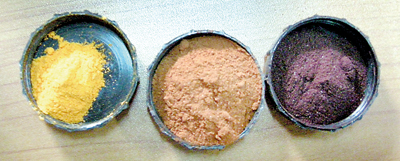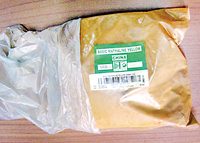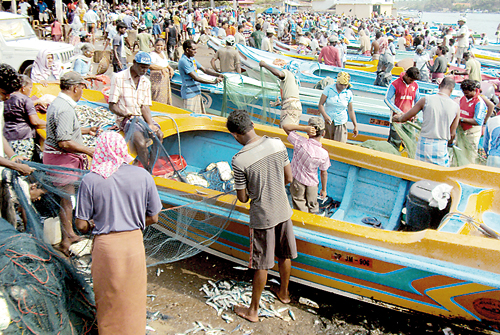News
The dye is cast on the fabric of taste
Despite being illegal, the use of edible food colouring in powdered chillie, turmeric, pepper and assorted spices is well known. But the recent raid by the Consumer Affairs Authority (CAA) has revealed the use of fabric dye to colour spices.

CAA’s Special Raid Squad Officer-in-Charge Pradeep Kalutaraarachchi
CAA’s Special Raid Squad Officer-in-Charge Pradeep Kalutaraarachchi said several places in Pettah and Bloemendhal areas were found to be using textile dye to colour chillie and turmeric powder, and action being initiated against the traders.
“Egg yellow, lemon yellow and blood-red food colouring has been used to colour powdered chillie, turmeric and mixed spices, despite action taken against traders. But textile dye is a new trend and can be very harmful,” he said.
“When questioned, the traders said that textile dye, sourced from batik manufacturers, colours larger quantities than edible food colouring,” he added.
The CAA found that 10 gm of dye is added to 20 kg of low quality spice powder or alternate flour, and sold in large quantities, mainly to food outlets and to small businesses which re-pack them. The bogus spices are sold in bulk at highly reduced rates.
“Low quality chillie powder is made from a mixture of discoloured dried chillies, the stem, seeds and sometimes with brick powder, hence no colour is found,” he said. The CAA also discovered turmeric powder made out of cornflour and yellow dhal (watana) powder, along with a synthetic aroma.
“At the market, a kg of turmeric powder is sold at Rs 600, while cornflour is about Rs 75 per kg and yellow dhal powder at about Rs 100 per kg. These are mainly distributed in Colombo and its suburbs, and are difficult to detect once in the market,” he said, adding that, the CAA has strengthened its raids and follow-up legal action.

The legitimate dyes that can be used

A packet of textile dye
Colombo University’s Chemistry Dept Head Prof. K.R. Ranjith Mahanama said that research was being conducted on this subject.
“It was found that many farmers, instead of waiting till the chillies ripen, pluck them early. These on drying, are either pale or yellow in colour. Hence, in order to enhance the colour, they add colouring. Synthetic flavour and fragrance is also used,” he said.
According to Prof. Mahanama, out of 10-15 samples obtained for research, more than half was adulterated.
He said that research also revealed the use of brick powder in chillie powder and dried papaya seeds in pepper, at present.
“Adulterated food is a menace in this country. Unfortunately, consumers are unaware and are unable to detect the difference between good and bad quality,” he said. Prof. Mahanama said the State should invest more on laboratory facilities where regular quality testing of samples can be done.
“The Government Analyst’s Department cannot be checking for foreign material in each and every sample. It is only via lab tests the adulterated material can be identified. Meanwhile, legal action against those involved should be strengthened,” he said.
The Medical Research Institute’s (MRI) Nutrition Dept Chief Dr Renuka Jayatissa said that non-edible dye can cause cancer if used for long periods of time. “Cancer is among the leading deadly illnesses caused by colouring. Textile dye which is not an edible content, will definitely have a negative effect on the body. It is said that the red colouring consumed for a long time can cause cancer in the bladder ,”she said.
Dr. Jayatissa said that those eating out should be extra careful of the location. “When it comes to spices, it is important to use reliable brands, even if it is a bit costly,” she said.
Follow @timesonlinelk
comments powered by Disqus




















